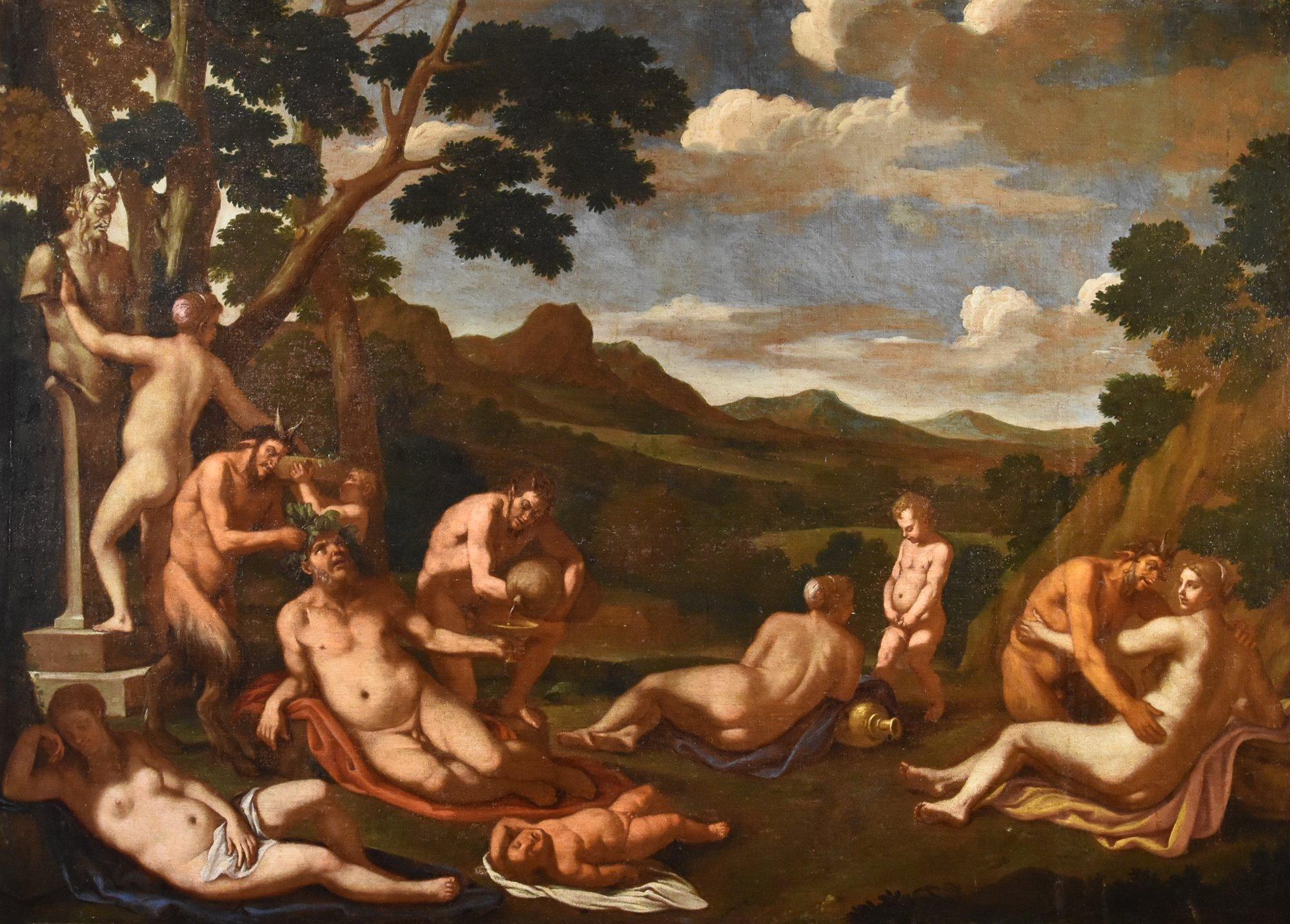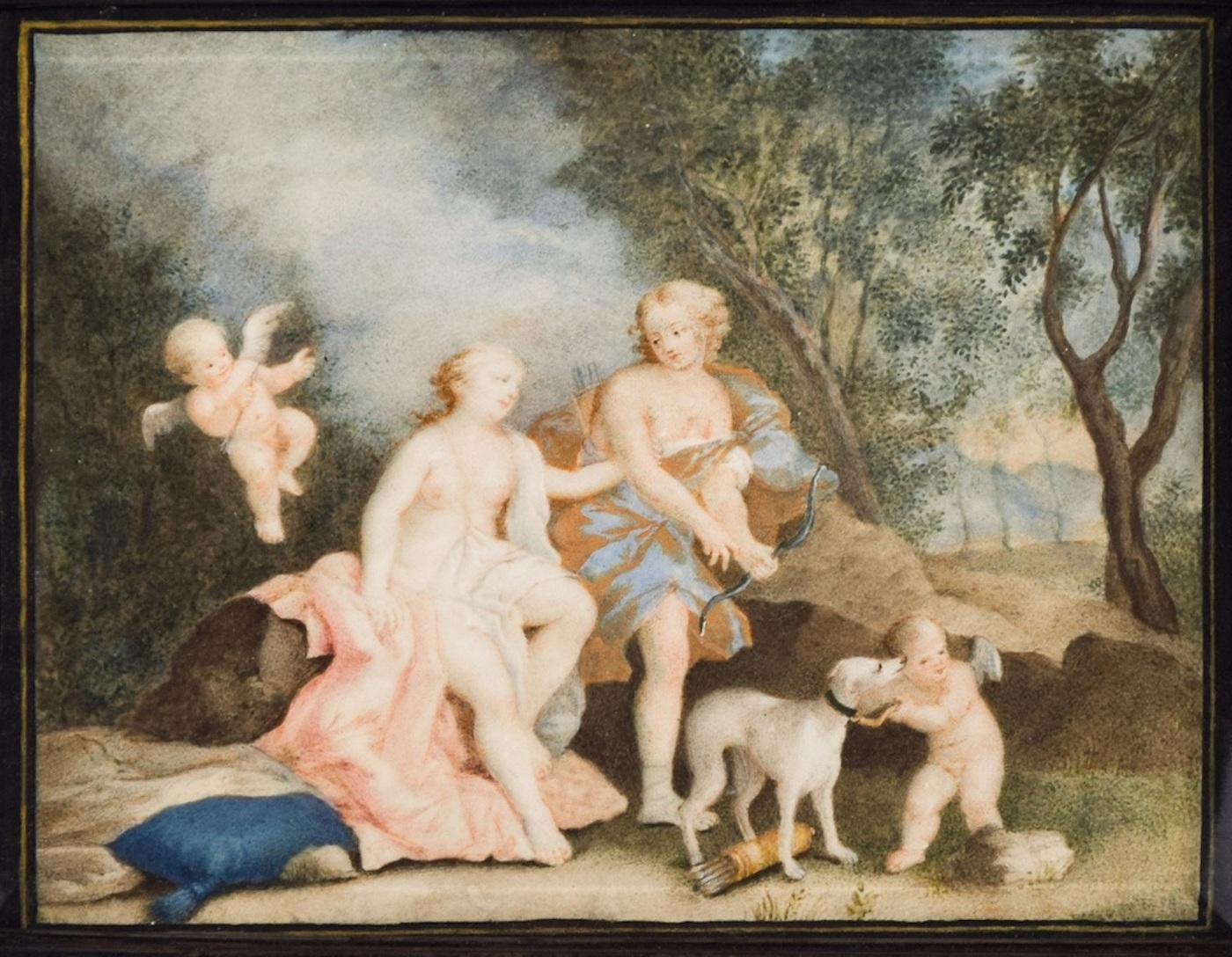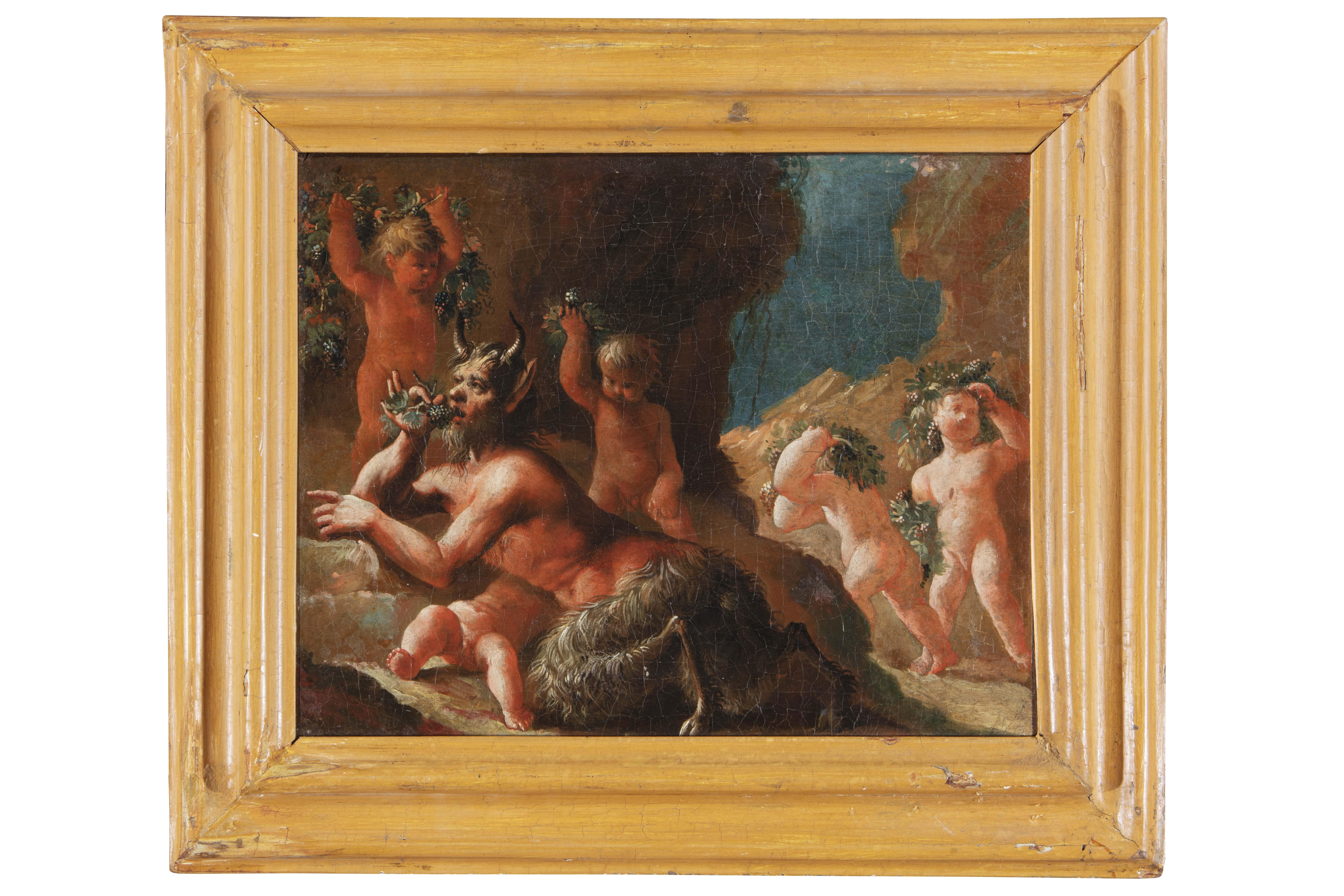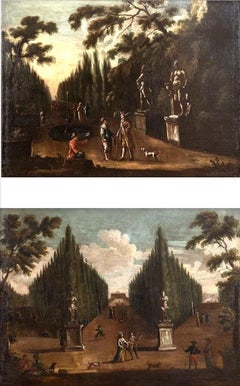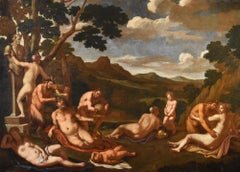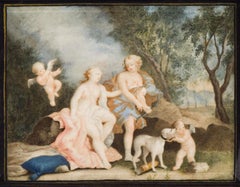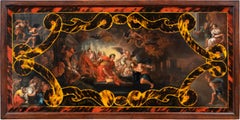Items Similar to Outstanding 18' century Paintings The Wedding Feast of Bacchus and Ariadne
Video Loading
Want more images or videos?
Request additional images or videos from the seller
1 of 18
UnknownOutstanding 18' century Paintings The Wedding Feast of Bacchus and Ariadne
$212,478.36
£159,619.69
€180,000
CA$297,810.73
A$323,476.42
CHF 171,253.73
MX$3,905,777.19
NOK 2,137,928.56
SEK 2,025,347.75
DKK 1,370,925.88
About the Item
Pair of large painting oil on canvas with the Wedding Feast of Bacchus and Ariadne scene .
Italy 18' century .
Amazing landscape background and roman Temple with classical architectural elements.
This dynamic scene by of Bacchanal the classical-mythological themes of the 17’ and 18’ century .
Within a lush garden are numerous figures in a variety of poses and costumes gathered around a stone altar which anchors the center of the composition. Some play instruments, some carrying the chariot of Bacchus the classical-mythological theme, and some are simply onlookers, while others make offerings at the altar that it may record either a sacrificial event or the Feast of Baal.
The other painting is represents the wedding of Ariadne and Bacchus
with numerous figures in dancing and festive of poses .Landscape background with classical landscape on the riverside .
Remarkable for the painter confident rendering, its flickering brushstrokes, and its brilliant palette.
Provenance from a historic Roman villa on the Via Appia.
Cm 225 x 155
- Dimensions:Height: 61.03 in (155 cm)Width: 88.59 in (225 cm)Depth: 1.58 in (4 cm)
- Medium:
- Movement & Style:
- Period:
- Framing:Framing Options Available
- Condition:
- Gallery Location:Rome, IT
- Reference Number:1stDibs: LU1004115835062
About the Seller
5.0
Vetted Professional Seller
Every seller passes strict standards for authenticity and reliability
1stDibs seller since 2018
32 sales on 1stDibs
Typical response time: 1 to 2 days
- ShippingRetrieving quote...Shipping from: roma, Italy
- Return Policy
Authenticity Guarantee
In the unlikely event there’s an issue with an item’s authenticity, contact us within 1 year for a full refund. DetailsMoney-Back Guarantee
If your item is not as described, is damaged in transit, or does not arrive, contact us within 7 days for a full refund. Details24-Hour Cancellation
You have a 24-hour grace period in which to reconsider your purchase, with no questions asked.Vetted Professional Sellers
Our world-class sellers must adhere to strict standards for service and quality, maintaining the integrity of our listings.Price-Match Guarantee
If you find that a seller listed the same item for a lower price elsewhere, we’ll match it.Trusted Global Delivery
Our best-in-class carrier network provides specialized shipping options worldwide, including custom delivery.More From This Seller
View AllPair of Italian 18' century Paintings with Gardens
Located in Rome, IT
Pair of Italian 18' century paintings , oil on canvas with Venetian Palace gardens , antiques sculptures and various figures .
Measurements with f...
Category
Mid-18th Century Old Masters Landscape Paintings
Materials
Oil
Pair of Italian 18' century Paintings with Gardens
Located in Rome, IT
Pair of Italian 18' century paintings , oil on canvas with Venetian Palace gardens , antiques sculptures and various figures .
Measurements with frame cm 75 x101
Category
Mid-18th Century Old Masters Landscape Paintings
Materials
Oil
Pair of Italian 18' century Paintings with Gardens
Located in Rome, IT
Pair of Italian 18' century paintings , oil on canvas with Venetian Palace gardens , antiques sculptures and various figures .
Measurements with frame cm 75 x101
Category
Mid-18th Century Old Masters Landscape Paintings
Materials
Oil
Pair of Italian 18' century Paintings with Gardens
Located in Rome, IT
Pair of Italian 18' century paintings , oil on canvas with Venetian Palace gardens , antiques sculptures and various figures .
Measurements with frame cm 75 x101
Category
Mid-18th Century Old Masters Landscape Paintings
Materials
Oil
Pair of Italian 18th Century Tempera on Canvas Classical Paintings "Capriccio"
By Pietro Paltronieri
Located in Rome, IT
A fine pair of huge Italian 18' century Capriccio with Classical ruins, tempera oil on canvas .
Atr.Pietro Paltronieri, il Mirandolese (Mirandola 1673-1741 Bologna).
Measurements ...
Category
Mid-18th Century Old Masters Landscape Paintings
Materials
Tempera
Pompeian Scene 19th century Painting Oil on Canvas Signed Egisto Sarri
By Egisto Sarri
Located in Rome, IT
Egisto Sarri
"Pompeian scene"
Oil on canvas, measure: cm 30 x 48 with a filly carved gilt - wood frame cm 46 x 64
Signature in the lower left-hand corner: "E. Sarri
Egisto Sarri
(Figline val d'Arno 1837 - Florence 1901)
Sarri studied at the Academy of Fine Arts in Florence under Giuseppe Bezzuoli and Enrico Pollastrini, and was one of Antonio Ciseri...
Category
19th Century Romantic Figurative Paintings
Materials
Oil
You May Also Like
Diana Boullogne Mythological Paint Oil on canvas old master 17/18th Century
Located in Riva del Garda, IT
Bon Boullogne (Paris, 1649 - Paris, 1717) workshop of
Episodes from the myth of Diana
oil painting on canvas
Dimensions: 84 x 114 cm.
with antique frame 100 x 132 cm.
The beautiful painting proposed shows a series of episodes taken from the myth of the divinity Diana, the Roman divinity of hunting, forests and wild animals, masterfully captured in this valuable painting, which shows a luxuriant wood, a favorite place of the divinity, as a theater of his adventures.
The composition opens, on the left, with a sort of presentation of the divinity, portrayed as an attractive young girl, surrounded by her faithful Nymphs, one of whom holds her quiver with arrows, and by one of her beloved dogs. hunting her.
The 'story' continues in the central part where we can see the divinity during a wild boar hunt...
Category
Late 17th Century Old Masters Paintings
Materials
Oil
$8,348 Sale Price
20% Off
Bacchanale Mythological Carpioni Paint Oil on canvas 17th Century Old master Art
Located in Riva del Garda, IT
Giulio Carpioni (Venice, 1613 - Vicenza, 1678), Attributable to
Bacchanale
Oil on canvas 98 x 132 cm. - In frame 120 x 154 cm.
This high-quality, beautifully preserved painti...
Category
17th Century Old Masters Paintings
Materials
Oil
$15,713 Sale Price
20% Off
Mythological Scene - Oil on Board - 18th Century
Located in Roma, IT
Mythological Scene is a mixed colored painting on board realized by Anonymous artist in the XVIII century.
The artwork represents a mythological scene with women and cherubs.
Inclu...
Category
18th Century Figurative Paintings
Materials
Board, Oil
Baroque mythological painter - 18th century figure painting - Helios and Phaeton
Located in Varmo, IT
European Painter (17th-18th century) - Helios and Phaeton.
63 x 135 cm unframed, 72 x 143.5 cm with frame.
Ancient oil painting on panel, in an integrated wooden frame (not signed)...
Category
17th Century Baroque Figurative Paintings
Materials
Wood, Oil
Baroque mythological painter - 18th century figure painting - Deucalion Flood
Located in Varmo, IT
European Painter (17th-18th century) - The Flood of Deucalion and Pyrrha.
63 x 135 cm unframed, 72 x 143.5 cm with frame.
Ancient oil painting on panel, in an integrated wooden fra...
Category
Late 17th Century Baroque Figurative Paintings
Materials
Wood, Oil
18th century By French Maestro Bacchanal Oil on canvas
Located in Milano, Lombardia
18th Century French Maestro
Title: Bacchanal
Medium: Oil on canvas
Dimensions: without frame 24 x 30 cm - with frame 33.5 x 39 cm
Antique shaped wooden frame lacquered in mustard col...
Category
18th Century Old Masters Figurative Paintings
Materials
Oil, Canvas
$10,576 Sale Price
20% Off
More Ways To Browse
Roman Temple
Pair Large Paintings
Stone Altar
Indian Man Painting
Jasmine Painting
Kader Boly
Lawyer Painting
Mario Tozzi
Michael Magrin
Native American Artist Paintings
Oil Painting Priest
Oil Paintings Paris Cafe
Paintings By Esther
Rebecca Johnson
Rene Smoorenburg
Rob Alexander
Salome With The Head Of John The Baptist
Samantha Buller
